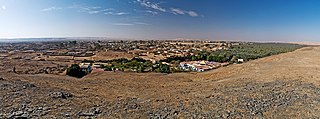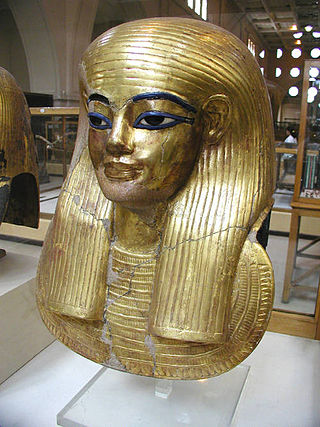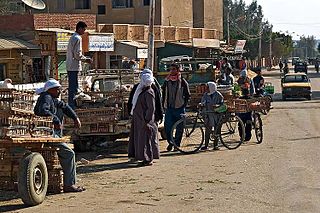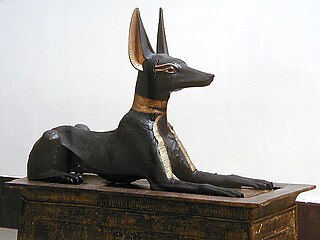
Anubis, also known as Inpu, Inpw, Jnpw, or Anpu in Ancient Egyptian, is the god of funerary rites, protector of graves, and guide to the underworld, in ancient Egyptian religion, usually depicted as a canine or a man with a canine head.

Saqqara, also spelled Sakkara or Saccara in English, is an Egyptian village in the markaz (county) of Badrashin in the Giza Governorate, that contains ancient burial grounds of Egyptian royalty, serving as the necropolis for the ancient Egyptian capital, Memphis. Saqqara contains numerous pyramids, including the Pyramid of Djoser, sometimes referred to as the Step Tomb, and a number of mastaba tombs. Located some 30 km (19 mi) south of modern-day Cairo, Saqqara covers an area of around 7 by 1.5 km.

Zahi Abass Hawass is an Egyptian archaeologist, Egyptologist, and former Minister of State for Antiquities Affairs, serving twice. He has also worked at archaeological sites in the Nile Delta, the Western Desert and the Upper Nile Valley.

The ancient Egyptians had an elaborate set of funerary practices that they believed were necessary to ensure their immortality after death. These rituals included mummifying the body, casting magic spells, and burials with specific grave goods thought to be needed in the afterlife.

Tomb KV60 is an ancient Egyptian tomb in the Valley of the Kings, Egypt. It was discovered by Howard Carter in 1903, and re-excavated by Donald P. Ryan in 1989. It is one of the more perplexing tombs of the Theban Necropolis, due to the uncertainty over the identity of one female mummy found there (KV60A). She is identified by some, such as Egyptologist Elizabeth Thomas, to be that of the Eighteenth Dynasty pharaoh Hatshepsut; this identification is advocated for by Zahi Hawass.

Bahariya Oasis is a depression and a naturally rich oasis in the Western Desert of Egypt. It is approximately 370 km away from Cairo. The roughly oval valley extends from northeast to southwest, has a length of 94 km, a maximum width of 42 km and covers an area of about 2000 km².

The tomb of Yuya and Thuya, also known by its tomb number KV46, is the burial place of the ancient Egyptian noble Yuya and his wife Thuya, in the Valley of the Kings. They were the parents of Queen Tiye, the chief wife of Pharaoh Amenhotep III. Their tomb was discovered in February 1905 by the Egyptologist James E. Quibell, excavating under the sponsorship of American millionaire Theodore M. Davis. The tomb was robbed in antiquity but preserved a great deal of its original contents including chests, beds, chairs, a chariot, and numerous storage jars. Additionally, the riffled but undamaged mummies of Yuya and Thuya were found within their disturbed coffin sets. Prior to the discovery of the tomb of Tutankhamun, this was considered to be one of the greatest discoveries in Egyptology.

Yuya was a powerful ancient Egyptian courtier during the Eighteenth Dynasty of Egypt. He was married to Thuya, an Egyptian noblewoman associated with the royal family, who held high offices in the governmental and religious hierarchies. Their daughter, Tiye, became the Great Royal Wife of Amenhotep III. Yuya and Thuya are known to have had a son named Anen, who carried the titles "Chancellor of Lower Egypt", "Second Prophet of Amun", "Sm-priest of Heliopolis", and "Divine Father".

Thuya was an Egyptian noblewoman and the mother of queen Tiye, and the wife of Yuya. She is the grandmother of Akhenaten, and great grandmother of Tutankhamun.

Tomb KV21 is an ancient Egyptian tomb located in the Valley of the Kings in Egypt. It was discovered in 1817 by Giovanni Belzoni and later re-excavated by Donald P. Ryan in 1989. It contains the mummies of two women, thought to be Eighteenth Dynasty queens. In 2010, a team headed by Zahi Hawass used DNA evidence to tentatively identify one mummy, KV21A, as the biological mother of the two fetuses preserved in the tomb of King Tutankhamun.
Joann Fletcher is an Egyptologist and an honorary visiting professor in the department of archaeology at the University of York. She has published a number of books and academic articles, including several on Cleopatra, and made numerous television and radio appearances. In 2003, she controversially claimed to have identified the mummy of Queen Nefertiti.
KV63 is a chamber in Egypt's Valley of the Kings pharaonic necropolis. Initially believed to be a royal tomb, it is now believed to have been a storage chamber for the mummification process. It was found in 2005 by a team of archaeologists led by Otto Schaden.

KV64 is the tomb of an unknown Eighteenth Dynasty individual in the Valley of the Kings, near Luxor, Egypt that was re-used in the Twenty-second Dynasty for the burial of the priestess Nehmes Bastet, who held the office of "chantress" at the temple of Karnak. The tomb is located on the pathway to KV34 in the main Valley of the Kings. KV64 was discovered in 2011 and excavated in 2012 by Susanne Bickel and Elina Paulin-Grothe of the University of Basel.

El-Bawiti is a town in the Western desert in Egypt. With 30,000 inhabitants, it is the largest settlement in the Bahariya Oasis.

Animal mummification was common in ancient Egypt. Animals were an important part of Egyptian culture, not only in their role as food and pets, but also for religious reasons. Many different types of animals were mummified, typically for four main purposes: to allow people's beloved pets to go on to the afterlife, to provide food in the afterlife, to act as offerings to a particular god, and because some were seen as physical manifestations of specific deities that the Egyptians worshipped. Bastet, the cat goddess, is an example of one such deity. In 1888, an Egyptian farmer digging in the sand near Istabl Antar discovered a mass grave of felines, ancient cats that were mummified and buried in pits at great numbers.

Taposiris Magna is a city established by Pharaoh Ptolemy II Philadelphus between 280 and 270 BC. The name means "great tomb of Osiris", which Plutarch identifies with an Egyptian temple in the city.
Tutankhamun's mummy was discovered by English Egyptologist Howard Carter and his team on 28 October 1925 in tomb KV62 in the Valley of the Kings. Tutankhamun was the 13th pharaoh of the 18th Dynasty of the New Kingdom of Egypt, making his mummy over 3,300 years old. Tutankhamun's mummy is the only royal mummy to have been found entirely undisturbed.

The Anubis Shrine was part of the burial equipment of the 18th Dynasty pharaoh Tutankhamun, whose tomb in the Valley of the Kings was discovered almost intact in 1922 by Egyptologists led by Howard Carter. Today the object, with the find number 261, is on display at the Egyptian Museum in Cairo, with the inventory number JE 61444.

Mummies 317a and 317b were the infant daughters of the ancient Egyptian pharaoh Tutankhamun of the Eighteenth Dynasty. Their mother is presumed to be Ankhesenamun, his only known wife, who has been tentatively identified through DNA testing as the mummy KV21A. 317a was born prematurely at 5–6 months' gestation, and 317b was born at or near full term. They are assumed to have been stillborn or died shortly after birth.
The archaeology of Ancient Egypt is the study of the archaeology of Egypt, stretching from prehistory through three millennia of documented history. Egyptian archaeology is one of the branches of Egyptology.

















